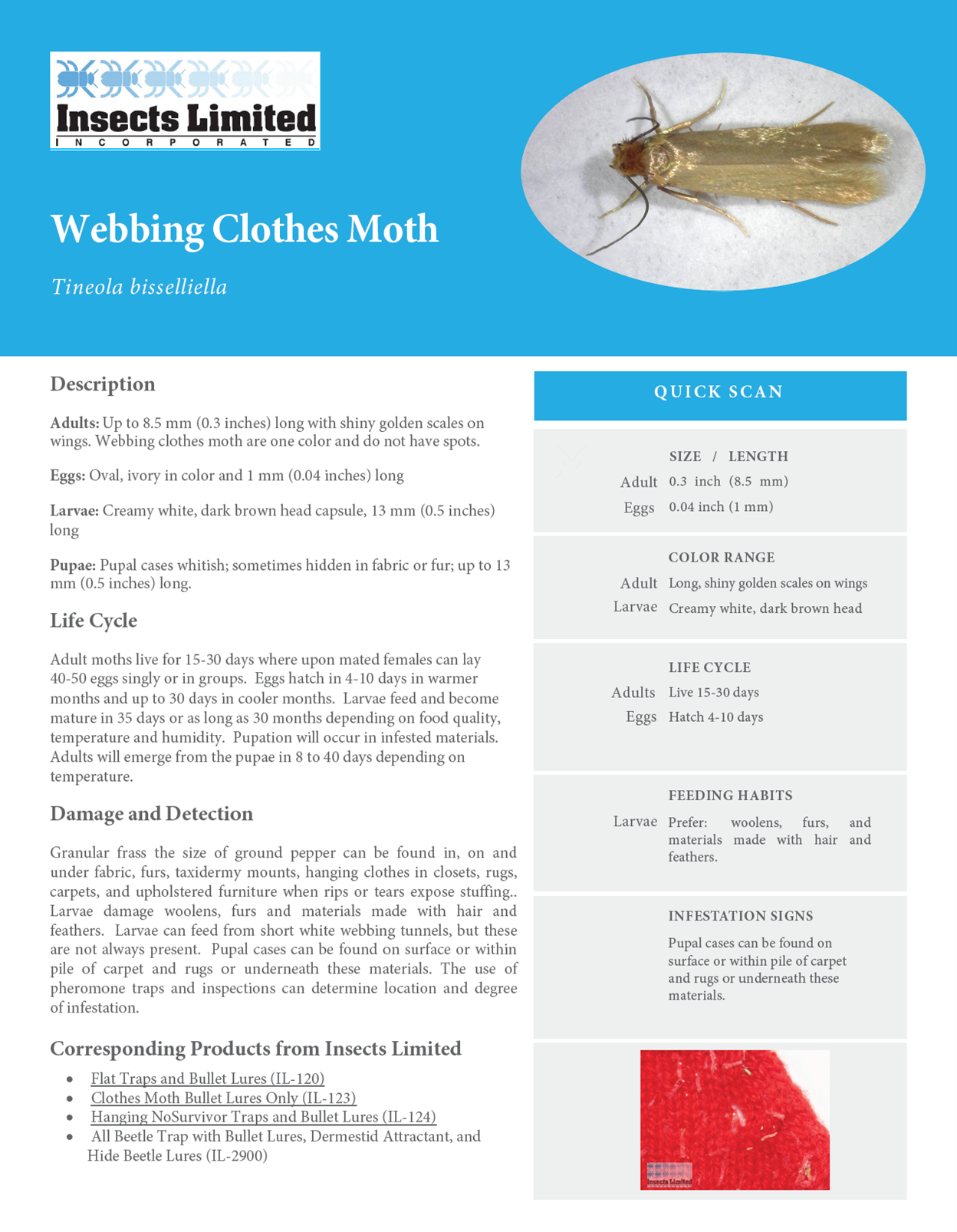Webbing Clothes Moth (Tineola bisselliella)
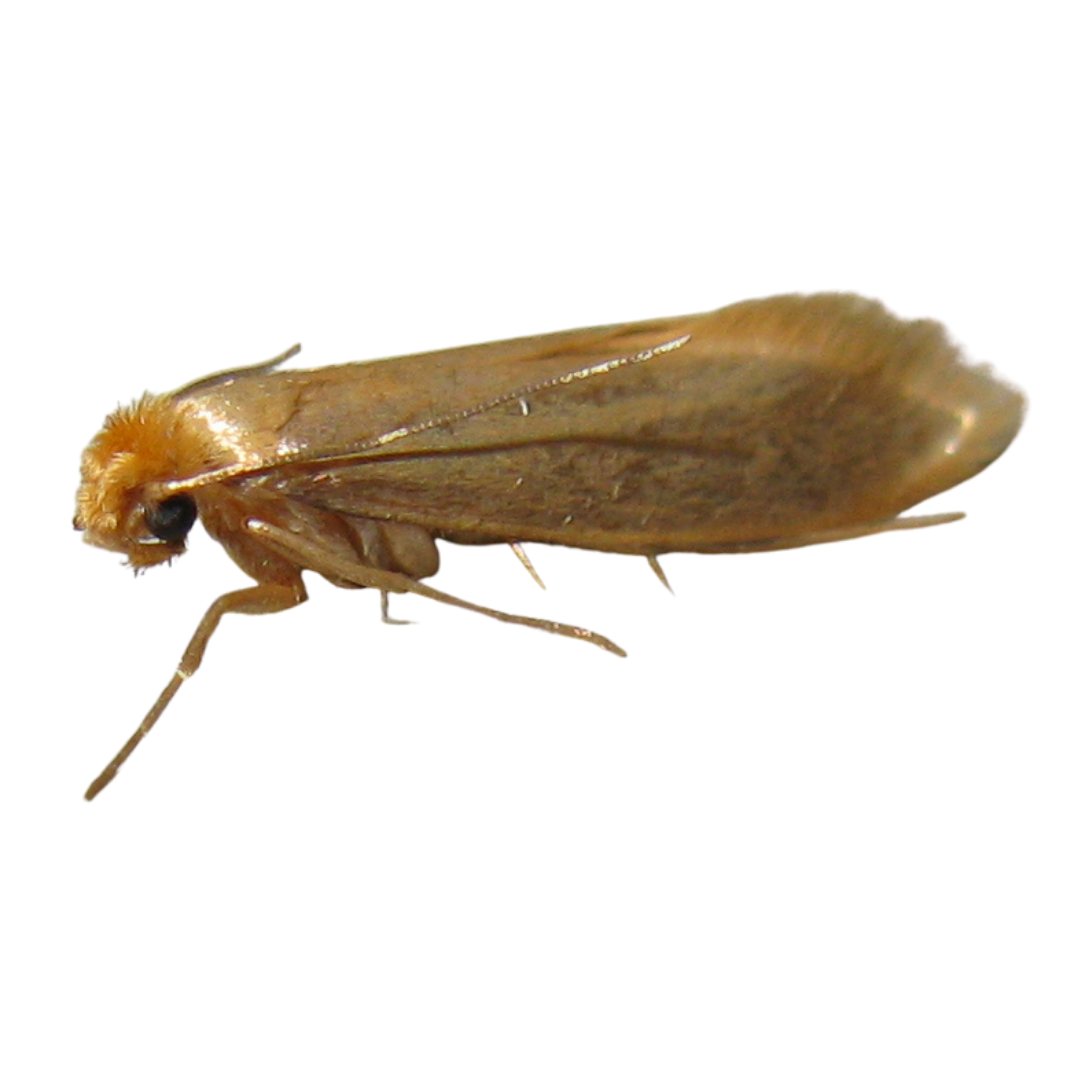
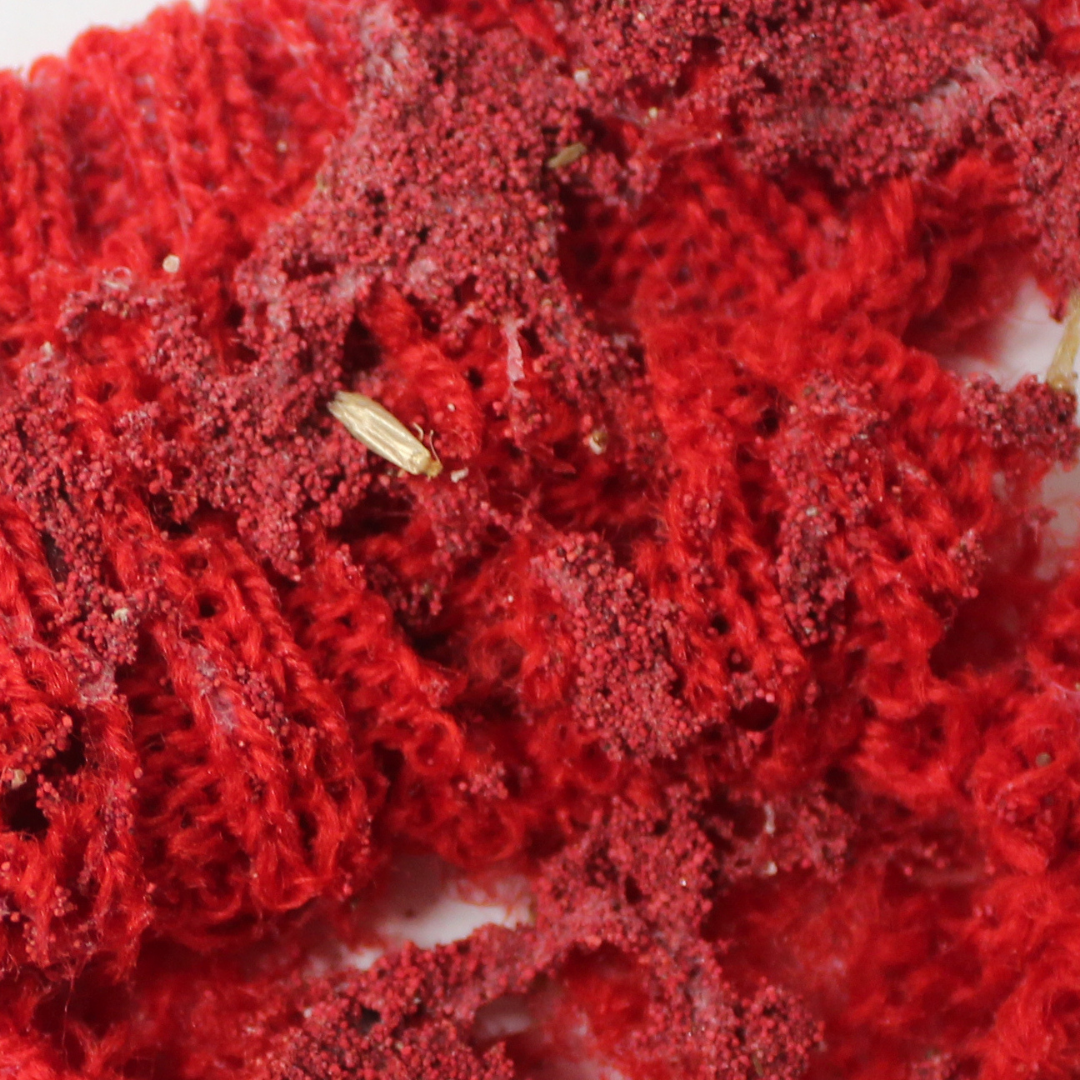
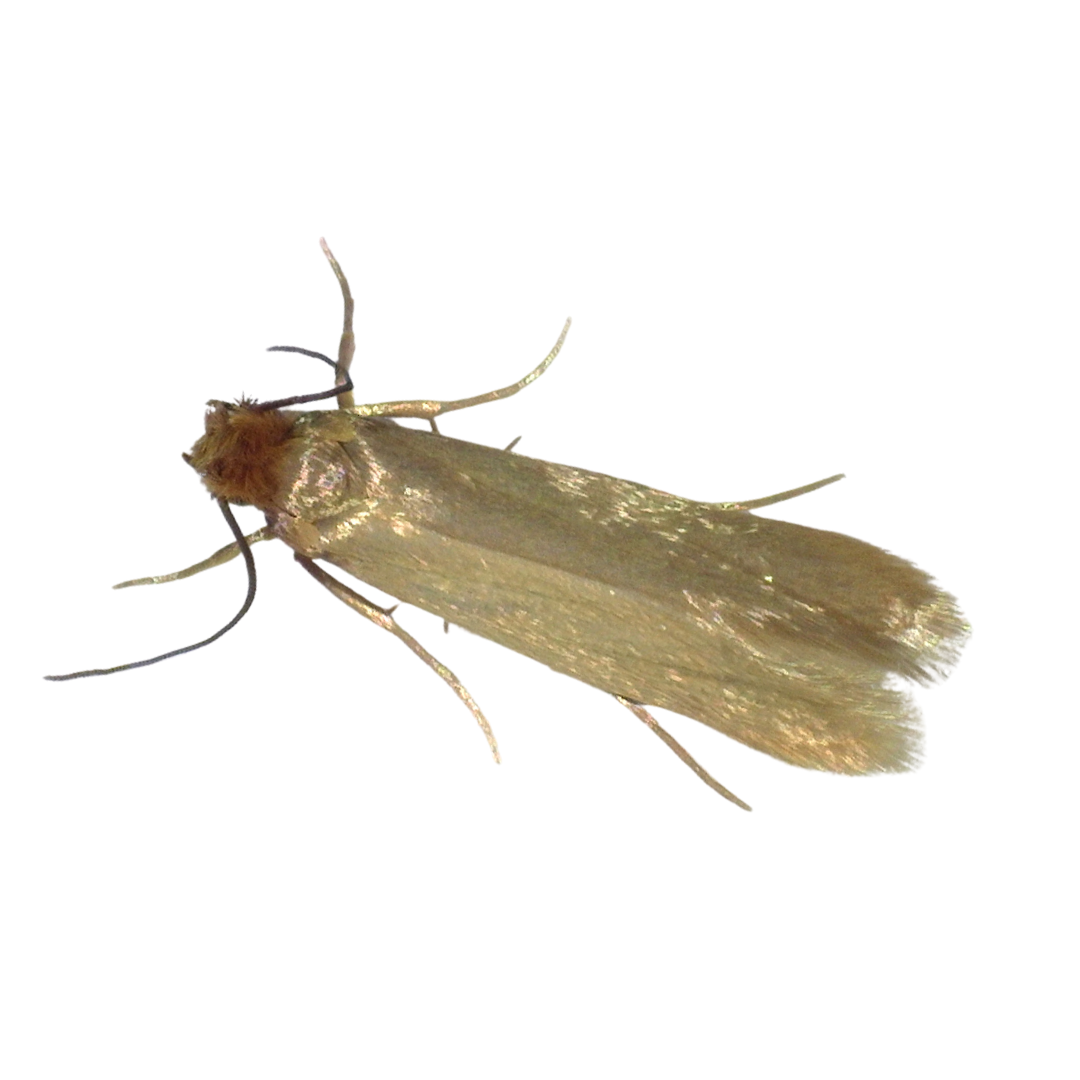
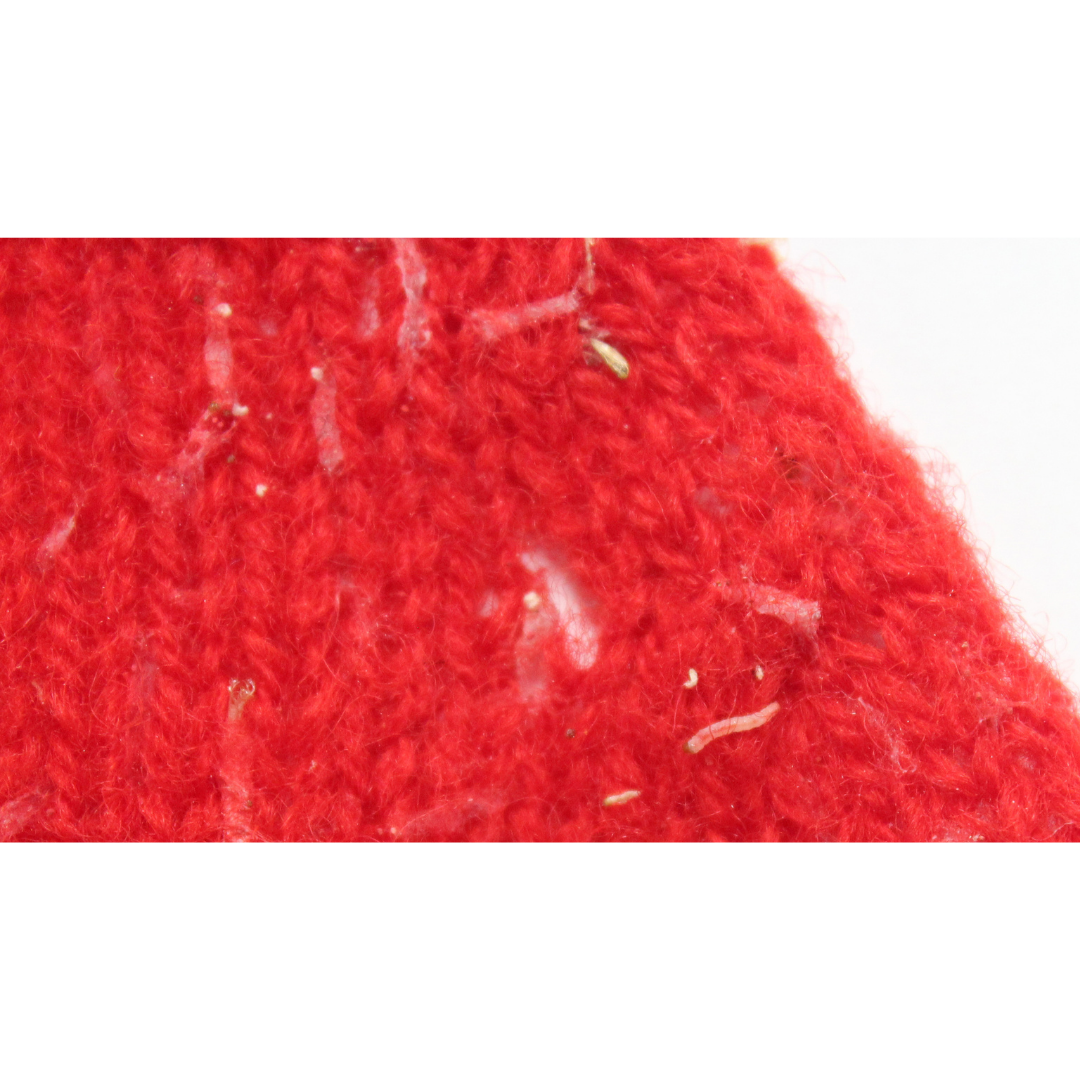
Webbing Clothes Moth Pheromones and Traps
Webbing Clothes Moth Description
Adults: Up to 8.5 mm (0.3 inches) long with shiny golden scales on wings. Webbing clothes moth are one color and do not have spots.
Eggs: Oval, ivory in color and 1 mm (0.04 inches) long
Larvae: Creamy white, dark brown head capsule, 13 mm (0.5 inches) long
Pupae: Pupal cases whitish; sometimes hidden in fabric or fur; up to 13 mm (0.5 inches) long.
Life Cycle of the Webbing Clothes Moth
Adult webbing clothes moths live for 15-30 days whereupon mated females can lay 40-50 eggs singly or in groups. Eggs hatch in 4-10 days in warmer months and up to 30 days in cooler months.
Larvae feed and become mature in 35 days or if 30 months depending on food quality, temperature, and humidity. Pupation will occur in infested materials. Adults will emerge from the pupae in 8 to 40 days depending on temperature.
Damage & Detection
Granular frass the size of ground pepper can be found in, on and under fabric, furs, taxidermy mounts, hanging clothes in closets, rugs, carpets, and upholstered furniture when rips or tears expose stuffing.
Webbing clothes moth larvae damage woolens, furs and materials made with hair and feathers. Larvae can feed from short white webbing tunnels, but these are not always present. Pupal cases can be found on the surface or within piles of carpet and rugs or underneath these materials.
The use of pheromone traps and inspections can determine location and degree of infestation.
Fun Facts about the Webbing Clothes Moth
Similar species include the casemaking clothes moth (Tinea pellionella) and brown dotted clothes moth (Niditinea fuscella).
Other common names for the webbing clothes moth include common clothes moth and clothes moth.
Like many clothes moth species, adult webbing clothes moths do not eat. Their larvae are vivacious feeders and damage natural fibers.
Webbing clothes moths initiate flight at temperatures above 12.5°C (55°F).
The pheromone that attracts webbing clothes moths also attracts other moth species including:
Casemaking clothes moth (Tinea pellionella)
Brown-dotted clothes moth (Niditinea fuscella).
Monitoring Tips & Tricks for Webbing Clothes Moth
Webbing Clothes Moth Monitoring Guidelines
Lure
Clothes Moth BULLET LURE® is the recommended lure to use when monitoring for this insect. It contains sex pheromone to attract male moths.
Lure Storage
Keep unopened lures in cool storage less than 16°C (60°F) or place in the freezer for extended storage. Lures can remain frozen for up to 24 months or at room temperature for 12 months to retain their full effectiveness for use afterwards.
Trap Designs Used with Lure
FLAT TRAPS are a low-profile sticky trap. This design is the preferred trap for this moth that does not fly well and would prefer to land on a flat surface and walk or jump to its destination.
NOSURVIVOR traps are diamond shaped sticky traps that can be hung from many locations. These devices should be used as an when utilizing flat traps is not an option and should be hung using the twist ties provided.
Webbing Clothes Moth Trap Placement & Use
Trap Placement Techniques
Pheromone traps can be placed year-round but are especially recommended when temperatures exceed 12.5°C (55°F). Floor pheromone traps like the Flat Trap are more effective at capturing Webbing clothes moth compared to hanging pheromone traps, however, hanging pheromone traps tend to stay clean longer and may allow for easier inspection.
Place Floor Traps in the bottom of clothes closets, on shelving or beneath furniture that is close to wool rugs or close to areas where moths are being seen. Spacing should be 1 trap per closet or 1 trap per every 200 square feet (9 square meters) room. In large areas, 1 trap per every 15 feet (3 meters) is recommended.
Place hanging pheromone traps 1.5 m (5 feet) above ground or at eye level to allow for easy inspection when monitoring traps. In areas such as a closet or home, place one or two pheromone traps per room.
In commercial areas such as warehouses or museums, place pheromone traps 7.5–15 m (25–50 feet) apart to determine the presence or absence of Webbing clothes moths. Increase pheromone trap density to 4.5–7.5 m (15–25 feet) apart to help locate the source of Webbing clothes moths.
Keep pheromone traps 7.5 m (25 feet) away from exterior doors. Webbing clothes moth pheromone traps are best utilized in areas that store items that contain natural fibers such as wool, hair, feathers, furs, and upholstered furniture (containing natural wools and leathers).
Trap and Lure Maintenance
Replace traps when glue is filled with insects or becomes dusty. Replace pheromone lures every 90 days. Replace all pheromone lures in a location at the same time. Do not cut the cap off the bullet lure. Do not stagger lure replacement over several weeks. Record date and number of catches to identify trending information.
Take this information with you
Webbing Clothes Moth Pheromone Products
Webbing Clothes Moth Behavior
Join Our Informed Community
Receive the latest industry updates as soon as they are published.






